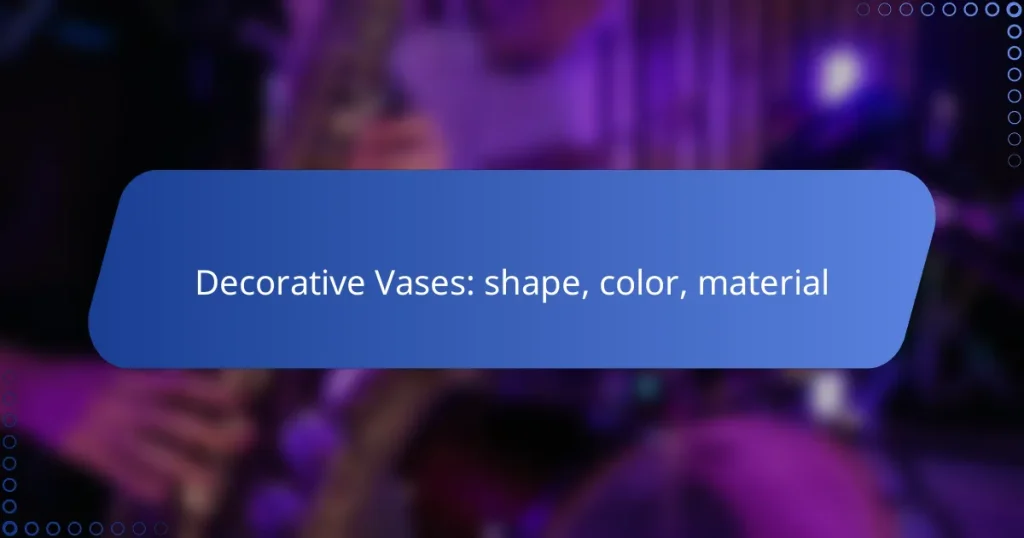Decorative vases serve as both functional and artistic elements in home decor, with shapes ranging from round and square to more intricate designs like trumpet and urn styles. The color of a vase significantly influences its visual impact, allowing it to either blend seamlessly with a room or serve as a striking focal point. Additionally, the materials used—such as ceramic, glass, metal, wood, and resin—each bring distinct qualities that enhance the vase’s aesthetic and durability.
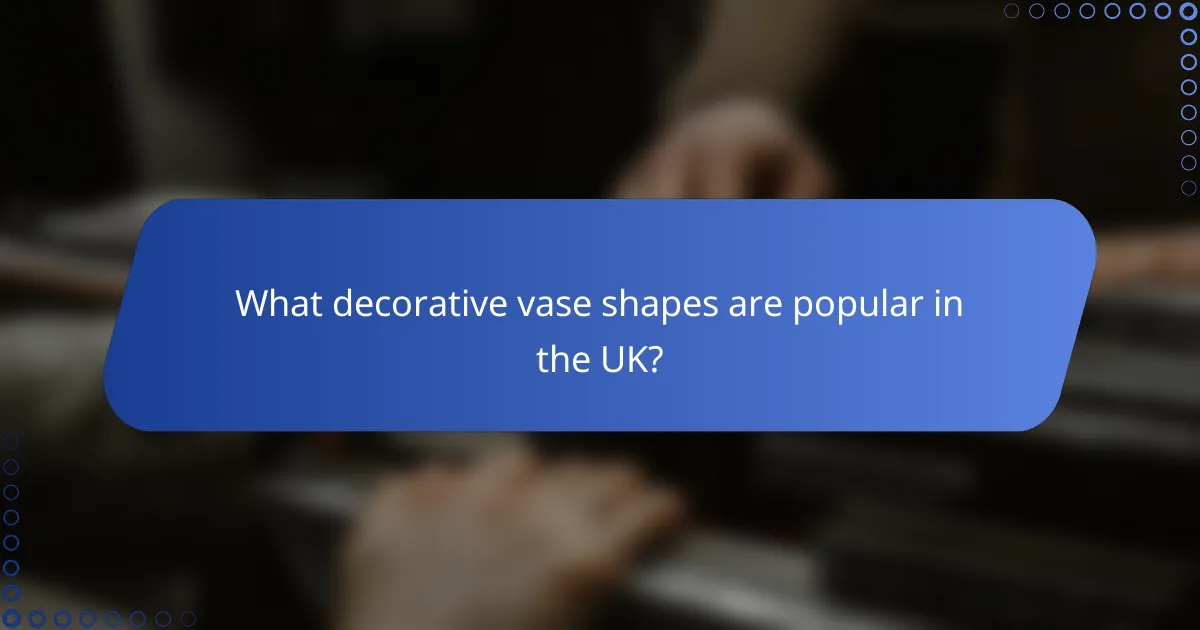
What decorative vase shapes are popular in the UK?
In the UK, popular decorative vase shapes include round, square, trumpet, urn, and bottle designs. Each shape offers unique aesthetic qualities and functional uses, making them suitable for various decor styles.
Round vases
Round vases are favored for their classic and versatile design, making them suitable for a wide range of floral arrangements. They can vary in size from small tabletop pieces to large floor vases, allowing for flexibility in placement.
When choosing a round vase, consider the height and width in relation to the flowers you plan to use. A taller vase can support long-stemmed flowers, while a wider base can accommodate a fuller bouquet.
Square vases
Square vases offer a modern and structured look, often used in contemporary decor. Their geometric shape provides stability and can create a striking visual contrast with soft floral arrangements.
These vases are available in various materials, including glass, ceramic, and metal. When selecting a square vase, ensure it complements the surrounding decor and fits the intended floral display.
Trumpet vases
Trumpet vases are characterized by their flared tops, which create an elegant silhouette perfect for showcasing tall flowers. This shape is particularly popular for formal arrangements and events.
When using a trumpet vase, consider the height of the flowers to ensure they are proportionate to the vase. This shape works well with single-stem flowers or a few select blooms to highlight their beauty.
Urn vases
Urn vases are traditionally shaped and often used as statement pieces in home decor. They can be quite large and are typically used for decorative purposes rather than functional floral arrangements.
These vases are often made from materials like ceramic or stone and can be placed indoors or outdoors. When selecting an urn vase, consider its weight and stability, especially if it will be displayed outside.
Bottle vases
Bottle vases have a narrow neck and a wider body, resembling traditional bottles. They are ideal for minimalist arrangements and can be used individually or grouped together for a more dynamic display.
These vases work well with single flowers or small clusters, making them perfect for creating a simple yet stylish look. When choosing bottle vases, consider varying heights and colors to enhance visual interest.
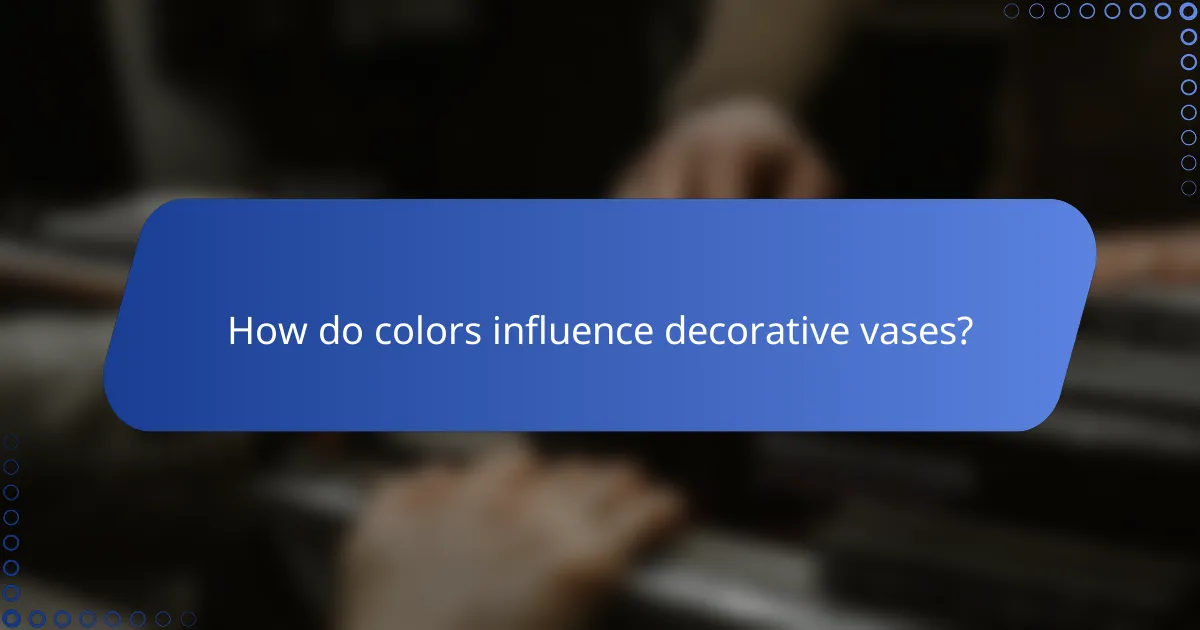
How do colors influence decorative vases?
Colors play a crucial role in the aesthetic appeal of decorative vases, impacting their ability to complement or enhance a space. The choice of color can evoke emotions, set a mood, and influence the overall design theme of a room.
Neutral colors for versatility
Neutral colors like white, beige, gray, and taupe offer versatility in decorative vases, allowing them to blend seamlessly with various interior styles. These shades can serve as a backdrop for other design elements, making them ideal for minimalist or contemporary settings.
When selecting neutral vases, consider textures and materials to add depth. For example, a matte ceramic vase can provide a modern touch, while a glossy finish can introduce a classic elegance.
Bold colors for statement pieces
Bold colors such as deep red, vibrant blue, or rich green can transform a decorative vase into a striking focal point. These hues draw attention and can energize a space, making them perfect for accent pieces in a more subdued environment.
When using bold-colored vases, balance is key. Pair them with neutral surroundings or complementary colors to avoid overwhelming the space. For instance, a bright yellow vase can pop against a gray wall, creating a lively contrast.
Pastel colors for subtle elegance
Pastel colors like soft pink, light blue, and mint green convey a sense of subtle elegance in decorative vases. These shades are often associated with tranquility and can soften the overall look of a room, making them suitable for romantic or vintage-inspired decor.
To enhance the effect of pastel vases, consider using them in groups or alongside other soft hues. A collection of pastel vases on a dining table can create a charming centerpiece, especially in natural light.
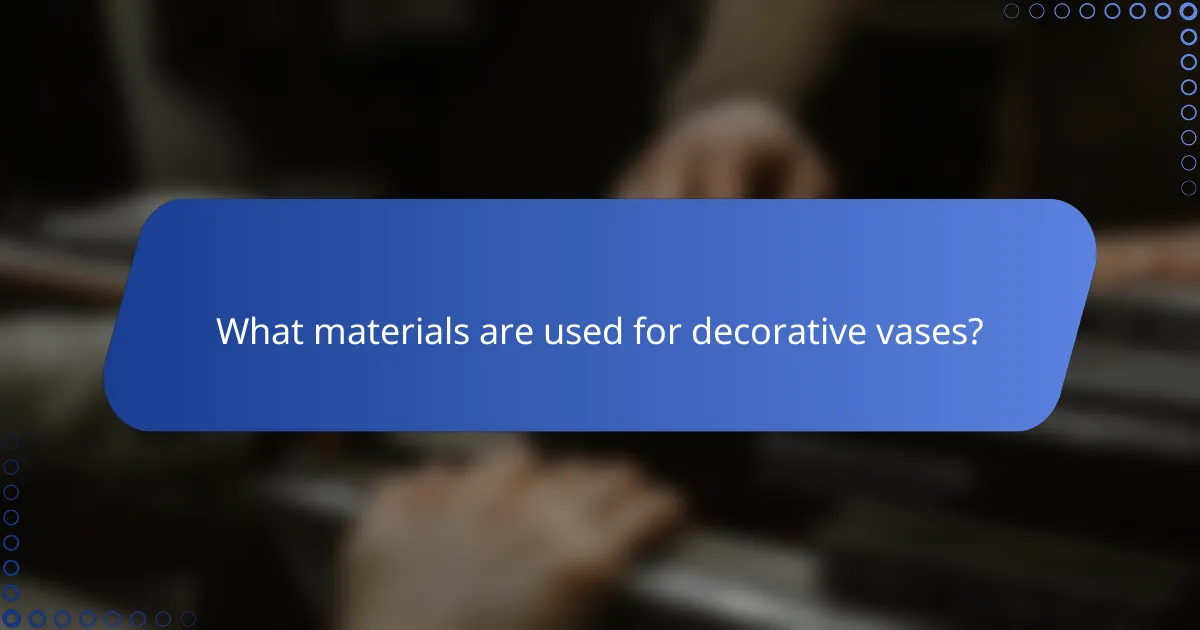
What materials are used for decorative vases?
Decorative vases can be made from a variety of materials, each offering unique aesthetic and functional qualities. Common materials include ceramic, glass, metal, wood, and resin, each contributing differently to the overall design and durability of the vase.
Ceramic vases
Ceramic vases are popular for their versatility and ability to hold intricate designs. They can be glazed or unglazed, with glazes providing a glossy finish that enhances colors and patterns. When selecting ceramic vases, consider their weight and fragility, as they can break easily if dropped.
These vases are often used for both fresh and dried flowers, but it’s essential to ensure they have a waterproof lining if used for live arrangements. Prices for ceramic vases can range from affordable to high-end, depending on the craftsmanship and brand.
Glass vases
Glass vases are favored for their transparency and elegance, allowing the beauty of flowers to shine through. They come in various shapes and sizes, from simple clear designs to elaborate colored or etched pieces. When choosing glass vases, consider their thickness and stability, as thinner glass can be more prone to breaking.
These vases are suitable for both fresh and dried flowers, but they require regular cleaning to maintain their clarity. Prices can vary widely, with basic glass vases being quite affordable, while designer pieces can be significantly more expensive.
Metal vases
Metal vases, often made from materials like stainless steel, brass, or copper, provide a modern and industrial look. They are durable and resistant to rust, making them suitable for both indoor and outdoor use. When selecting metal vases, consider the finish, as some may require polishing to maintain their shine.
These vases are typically used for dried arrangements or as decorative pieces without flowers. Prices for metal vases can range from budget-friendly options to high-end designer items, depending on the material and craftsmanship.
Wooden vases
Wooden vases offer a natural and rustic aesthetic, often showcasing the grain and texture of the wood. They can be carved into intricate designs or left simple and organic. When choosing wooden vases, ensure they are treated to prevent moisture damage, especially if used for fresh flowers.
These vases are best suited for dried arrangements or as standalone decorative items. Prices can vary based on the type of wood and craftsmanship, with unique handcrafted pieces often commanding higher prices.
Resin vases
Resin vases are lightweight and can mimic the appearance of other materials like glass or ceramic. They are often available in vibrant colors and unique shapes, making them a popular choice for modern decor. When selecting resin vases, check for UV resistance if they will be placed in direct sunlight, as some may fade over time.
These vases are versatile and can be used for both fresh and dried flowers. Prices for resin vases are generally affordable, making them accessible for various budgets.

How to choose the right decorative vase for your home?
Choosing the right decorative vase involves considering the style of your room, the size of the vase relative to the space, and the types of flowers you plan to use. A well-selected vase enhances your decor and complements your floral arrangements.
Consider the room’s style
The style of your room plays a crucial role in selecting a decorative vase. For a modern space, opt for sleek, minimalist designs, while traditional rooms may benefit from ornate, classic vases. Ensure the vase’s aesthetic aligns with your overall decor theme.
Materials also matter; glass and ceramic are popular choices that can suit various styles. For a rustic look, consider wooden or terracotta vases that add warmth and texture to the space.
Match vase size to space
Size is a key factor when choosing a decorative vase. A large vase can serve as a statement piece in a spacious room, while smaller vases are better suited for intimate settings. Aim for a balance where the vase complements the surrounding furniture and decor.
As a rule of thumb, a vase should be about one-third the height of the table or surface it sits on. This proportion helps create visual harmony and ensures the vase does not overwhelm the space.
Think about flower compatibility
Not all vases work well with every type of flower. Consider the shape and size of the flowers you intend to display; tall, slender flowers may require a narrow vase, while fuller blooms need a wider opening. This compatibility ensures that the flowers are showcased effectively.
Additionally, some flowers may require water while others are better suited for dried arrangements. Choose a vase that accommodates your floral preferences, whether it’s a water-holding design or a decorative piece for dried stems.
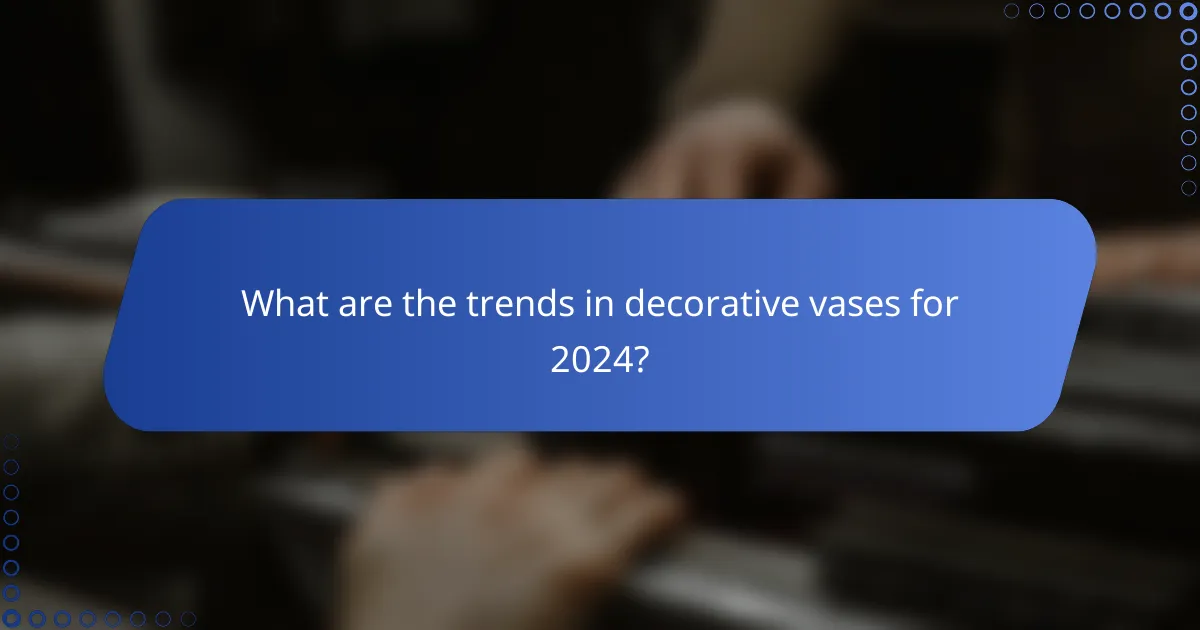
What are the trends in decorative vases for 2024?
In 2024, decorative vases are trending towards eco-friendly materials and minimalist designs, reflecting a growing emphasis on sustainability and simplicity in home decor. These trends prioritize both aesthetic appeal and environmental consciousness, making them popular choices for modern interiors.
Eco-friendly materials
Eco-friendly materials are gaining traction in the decorative vase market as consumers become more environmentally aware. Materials such as recycled glass, bamboo, and biodegradable ceramics are increasingly used to create stylish yet sustainable vases.
When choosing eco-friendly vases, look for products that are made from renewable resources or that have a lower carbon footprint. Brands often highlight their sustainable practices, so check for certifications or labels that indicate environmentally friendly production methods.
Minimalist designs
Minimalist designs focus on simplicity and functionality, often featuring clean lines and neutral colors. This trend allows decorative vases to blend seamlessly into various interior styles, from modern to Scandinavian, enhancing the overall aesthetic without overwhelming the space.
To incorporate minimalist vases into your decor, opt for pieces that emphasize form over embellishment. Consider using a few well-placed vases in varying heights to create visual interest while maintaining a cohesive look. Avoid overcrowding surfaces to keep the minimalist vibe intact.
